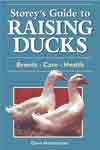
Book Review
 |
|
On a weekly basis, I get requests from people seeking accurate information on how to go about raising ducks correctly. They have questions about incubation and rearing practices, housing facilities and ponds, predator control and how to cope with disease and injuries. The list of concerns goes on and on. I do my best to help, but time constraints make really detailed answers difficult. Now there is a book that I feel is the reference everyone can use. I am not a seller of this book and have no economic interest in it. I simply recommend it. |
The book is titled STOREY'S GUIDE TO RAISING DUCKS. It is a paperback book of 316 pages and consists of 18 chapters plus a comprehensive set of useful appendices. It is available directly from the author and most certainly through other sources for $18.95 plus postage.
The book is written to offer something to every reader, from the novice contemplating the purchase of ducks for the first time to the experienced waterfowl breeder. For example, there are detailed comparisons of the qualities ducks versus most other forms of poultry in both general terms and later in very specific ways such as the nutritional content of the eggs, costs per unit of meat, foraging ability, and resistance to disease to name but a few. All aspects of keeping ducks are discussed in great detail from characteristics of their behavior to their requirements in feeding, housing, protection from predators and good rearing practices. Chapters take the reader from selecting the right breed to fitting birds for exhibition. In the chapter on incubation, for example, the author takes the reader step-by-step from preparing the breeding flocks through all the steps that lead to successful hatches. The author is not dogmatic in his approach to the subject and does not pretend that his system is the only good one. It is hard, however, to ignore the advice of someone who hatches 10,000 ducklings and goslings consistently year after year. I thought that the chapters on breed descriptions, feeding programs, and health problems were especially strong and well done but to tell you the truth, I didn't buy STOREY'S GUIDE TO RAISING DUCKS for the content of those chapters. I have known for some time that this book would contain extensive information on duck color patterns and Chapter 10 is what I have been waiting for. Entitled Understanding Duck Colors, it is a thorough explanation of the genetic makeup of almost every color pattern involved in any breed of domestic duck. Included in the coverage of each color pattern are common faults and breeding tips. The numerous pictures of ducklings exhibiting the various color patterns at hatch will prove very useful to many readers. Each section also includes a breakdown of the color gene composition of each pattern which is still Greek to me, I must confess. In short, the chapter lets the reader pull from it information on several levels. Muscovy breeders will be delighted with the detailed coverage of Muscovy patterns including descriptions of 18 color variations. To my knowledge, this is the first widely available publication to do so.
The book is extremely well illustrated with pictures and drawings of high quality. Of special value to the reader are numerous insights garnered from David's 40 or so years of experience raising waterfowl. Some things one usually learns only from personal experience in the absence of a book of this nature. Only a breeder of Magpies would know, for example, that the colored "cap" on the head of a female will often recede or disappear altogether as the bird ages. Only someone who has raised all the breeds and has used them in the garden would know that the Runners are the most useful hunters of slugs and insects in the garden. There are literally dozens of such observations.
The bottom line is, this is the best all around treatment of the topic of raising domestic ducks that I have seen to date. It is a great starting place for anyone wanting general guidance and a worthwhile reference for the experienced breeder.
Holderread's Waterfowl Farm
P.O. Box 492
Corvallis, OR 97339 Originally published: 02-19-2008
Last updated: 03-04-2008
|





